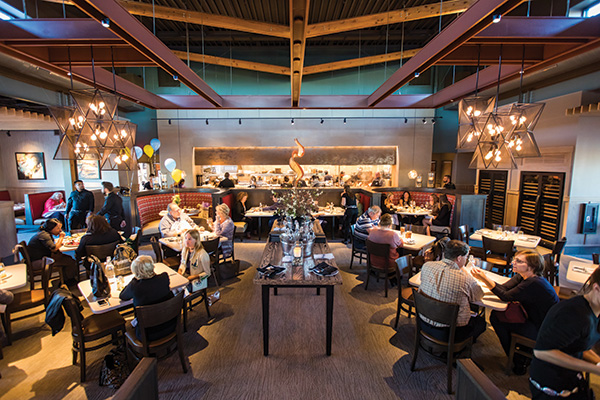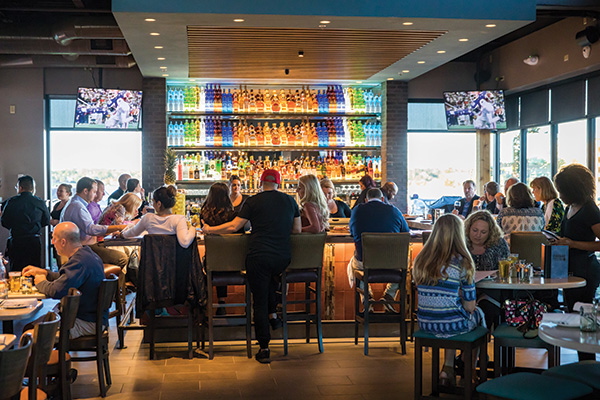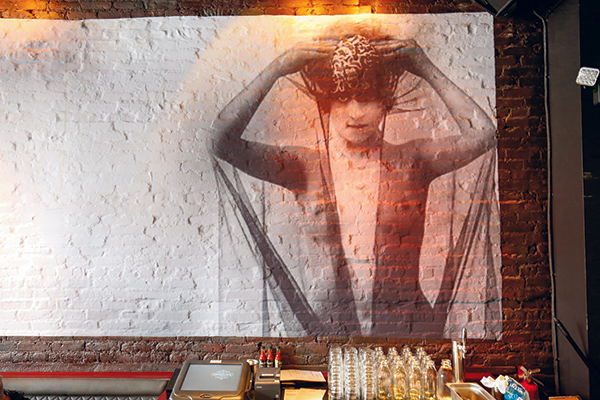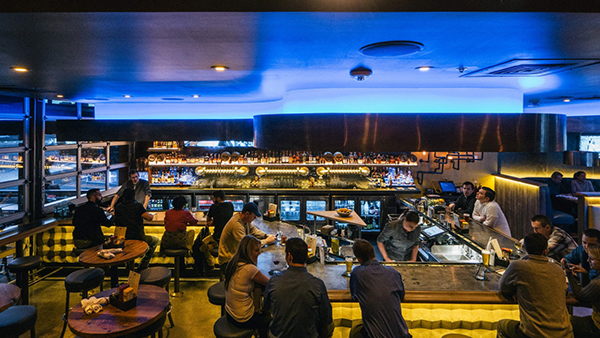This polished-casual concept is tossing aside the stiff feel of traditional steakhouses in search of openness and energy and a young customer base.
 The high ceilings in the main area of Firebirds’ dining room offer the feeling of openness, while dropped elements on the side provide a more intimate experience for guests. Images courtesy of Deremer StudiosIf you were asked to describe Millennials, there’s just no way that “formal” or “stodgy” would be words that come to mind. It’s a generation that’s famously open and frank, and one that doesn’t value ceremony.
The high ceilings in the main area of Firebirds’ dining room offer the feeling of openness, while dropped elements on the side provide a more intimate experience for guests. Images courtesy of Deremer StudiosIf you were asked to describe Millennials, there’s just no way that “formal” or “stodgy” would be words that come to mind. It’s a generation that’s famously open and frank, and one that doesn’t value ceremony.
While plenty of restaurant concepts are reworking their businesses to appeal to these younger guests, the Millennial mindset poses a particular challenge to the traditional steakhouse. With its low lighting, its reserved atmosphere and a dining experience bordering on ritual, this niche runs counter to how many
Millennials live and what they look for.
Recognizing this, Charlotte, N.C.-based Firebirds Wood Fired Grill recently introduced a new prototype designed to appeal to this generation and younger.
“We wanted to make sure we continued to capture the next generation: not only Millennials, but the generation following those folks as well. We didn’t want to feel like Mom and Dad’s old stodgy steakhouse. And while we feel that we are not, we wanted to make sure by making this adjustment,” says Vice President of Marketing Stephen Loftis.
What Millennials Want
In the eyes of the Firebirds project team, there’s a clear link between what Millennials are after and what they aren’t. Formal and stiff is out; energy and experience is in.
“One of the things the younger generation wants is a place to go and be part of activity. Just showing the inside out was important for Firebirds in order to attract all generations, really,” says Mimi Williams, associate partner at StarrDesign, which served as the architect and interior design firm for this project.
Communicating the activity at Firebirds, then, was one of the prototype’s design priorities. This starts from the outside. While the chain’s old design had windows on just two sides, the new design has large windows on three sides. These provide potential guests driving or walking by with a clear view of the interior and all activity.
 The outdoor patio includes accordion windows that open completely as well as a two-sided fireplace that’s shared with the interior bar.
The outdoor patio includes accordion windows that open completely as well as a two-sided fireplace that’s shared with the interior bar.
Other brand elements are also communicated with the building’s exterior. Fire and flight are two of the restaurant’s themes. The outside of the building, then, showcases the restaurant’s chimney (home of the exterior signage) along with charred bricks and three exterior lanterns. In combination with wooden overhangs and illuminated wood soffits, such elements “give this glowing warmth to the building, which we think makes it more approachable,” Williams says.
The restaurant’s main entrance is on the side of the building, relative to the street. Guests walk into a vestibule and then enter the Firebar bar and lounge, a fun, high-energy space where they can grab a drink and a bite to eat.
One of the first things guests see when they come into the Firebar is the barback display: an underlit collection of liquor bottles arranged by color. These sit on acrylic shelves of varying depths, creating a cascading, waterfall-like effect.
This liquor display is a holdover from the previous design. Other elements of the bar changed, however, and are meant to express the restaurant’s fire theme. The bar top is a sealed, charred fir; the front is made with a textured, slightly irregular glazed tile with linear glass tile accents running vertically, expressing the movement of flames, Williams says.
The fire theme goes from suggested to explicit with the bar’s fireplace — a gas unit with wood for the restaurant’s wood-fired grill stored below. In the previous prototype, the fireplace separated the bar from the dining area to the left. Now, it sits against an outer wall and, with openings on both sides, serves both the bar and the patio.
While this shift upgrades the patio experience, that wasn’t the main reason for the move. “Before, [the fireplace] served as a divider between the bar and the dining room. There was not a clear connection between them. We wanted it to feel like one unified space, so we moved that fireplace element to the exterior of the building,” Williams says.
While the designers were after more connection between the two spaces, they didn’t want the restaurant to feel like a box. To distinguish the bar from the dining area, the new design makes use of a banquette against a metal divider wall with a chevron-like pattern cut into it. Other seating options in the bar include high tops with backless stools (that make gathering around the tables easier) as well as stools (with backs) at the bar itself.
 The main dining room includes a center server station, eliminating the number of steps it takes to serve guests while allowing the chain to display its new sparkling water offering.
The main dining room includes a center server station, eliminating the number of steps it takes to serve guests while allowing the chain to display its new sparkling water offering.
Notably, the tables at the new Firebirds aren’t made from hardwood but from a light-colored solid-surface material that helps create a more casual atmosphere, says Williams. “We went away from their typical granite and wood tabletops and used a lighter tabletop just to create a few more pops of light throughout the space. Once again, we were trying to get away from the dark feel of a steakhouse. Playing with contrast is something we were working on with this restaurant.”
The restaurant’s dining room sits to the left of the bar in the new prototype. While the bar has its fireplace, on the exact opposite side of the prototype is the semi-open kitchen, where a window provides guests with a partial view of the action. “We created an intentional view into the kitchen rather than just opening it up,” Williams says. “This intentional view allows you to just see the fire grill and the people working behind it, the movement, but not necessarily everything that’s going on.”
Putting the kitchen on display in a polished-casual concept meant that the designers had to upgrade the finishes in and around the space, added Williams. In this case, they added oversized porcelain tiles above the pass-thru window, then added LED down lighting, giving the tiles a slight sheen. Surrounding that design element are large beige tiles. Behind the cookline is another clay-colored tile, along with a few spaces that use a similar colored fiber-reinforced polymer.
The dining area itself has three main sections, a larger space in the center and two smaller spaces on each side. The smaller sections are designed to be more intimate, with wooden ceiling elements lowering the ceiling height to around 10 feet, compared with the 18-foot ceilings in the middle section. Seating in these sections includes booths, banquettes and four-top tables. Like in the bar, the tables throughout the dining room are made of a solid-surface material. The dining room tables, however, are shaded a bit lighter, helping the food pop a bit more, says Williams.
Seating in the main section of the dining area is a mix of rectangular and round booths along with four tops. Dead center in this area is a long server station that holds menus, flatware and sparkling water, along with a floral display.
Notably, this server station wasn’t designed as a server station. “The intent out of the gate was to have a 16-person community table that could hold multiple parties or one large party,” says Loftis. “It created a little too much congestion in the dining room, so we turned it into a server station.”
This conversion has helped Firebirds from both an operations and a branding perspective: It has cut down on the number of steps servers take and allowed the chain to create a sparkling water display that highlights Firebirds’ elevated customer experience.
Going forward, the chain is intentionally designing a server station in that space, though it will likely be a bit shorter (perhaps allowing for a few more seats) and have an additional level, noted Williams.
Value Engineering, Changing for Real Estate
 The colored bottle display carried over from Firebirds’ previous design. The bar’s beer taps were made more visible in keeping with the chain’s desire to offer a more relaxed and approachable atmosphere.
The colored bottle display carried over from Firebirds’ previous design. The bar’s beer taps were made more visible in keeping with the chain’s desire to offer a more relaxed and approachable atmosphere.
This was just one of the changes that has been made to the new prototype in the months since its opening. As with any new restaurant, the design and operations teams have found items that do and don’t work, as well as what is and isn’t preferred.
The lighting package, for instance, is undergoing significant changes as new stores get built. The prototype’s dining room includes large hourglass-shaped light fixtures that are being removed at the owner’s preference.
In addition, the LED track lighting in the space has changed. “The LED is really cold on the lighter tables, so we had to make a lot of adjustments to get LED light to be warmer on those tabletops. That can be done through the use of a lens or by moving to a warmer temperature fixture, going from a 2700 kelvin lamp to a 2500 kelvin lamp,” Williams says.
Other changes involve the Firebar. The dimensions of the U-shaped bar itself are a bit too large, says Williams, so it will be narrowed to cut down on server steps. More significant, though, are the changes to the bar top. While the charred fir is on point from a brand perspective, it’s presenting maintenance issues in practice. “The problem with wood is that it moves. It shrinks and contracts, so it pulls apart. No matter how much we have sealed the thing, it keeps moving. That’s the nature of wood. We’re kind of experimenting to see if we want to move forward with that,” says Williams.
Then, of course, there is the usual economizing that goes on with any project. In the prototypes, the LED track lighting is hidden in an inverted king truss. While the design team is happy with that element, it’s also costly. Going forward, the designers will use a straight joist. The height of the interior ceiling may also be lowered slightly from its current level of roughly 18 feet. While the high ceiling creates a grand space, bringing it down will allow for structural changes that lower construction costs. Additional structural changes should also make the building cheaper and make the rooftop less crowded with mechanical equipment.
On top of these practical changes to the design, the prototype will typically be changed on a store-to-store basis due to external factors, primarily related to real estate, Williams says.
Competition for quality locations is intense, which means Firebirds may be willing to open in structures with unusual footprints. That can impact the desired customer experience, says Williams.
The entire restaurant is built around the idea of fire, with two main attractions: the fireplace and the exposed wood-fired grill. The prototype’s strategic layout points guests to those two elements. In a space with a non-standard footprint, creating a flow that smoothly directs guests to those two features is difficult.
In addition, many developments and jurisdictions with the demographics to attract a polished-casual operation like Firebirds have codes governing exterior materials and signage. In a buyer’s market, it might be easier for Firebirds to stick to its prototype, but that’s just not the reality of commercial real estate today.
“There could be height restrictions, and therefore we have to lower one of our main elements, which is our chimney. There could be color restrictions. Sometimes out west we have to go with lighter materials. It’s a lot of back and forth with the developer,” Williams says.
The goal of course will be to keep the core, the heart of the Firebirds experience — wood-fired cooking in an energetic, elevated environment — alive in the new design, no matter what compromises are made for new builds.
This core, after all, is what Firebirds is counting on to take it from a traditional steakhouse to a more modern concept that will appeal to generations of diners seeking a different look and experience. “We are making sure that we are still current, relevant as trends change and populations continue to grow up and even age a little bit,” Loftis says. “You’ve got to continue to evolve in this space.”
Snapshot
- Headquarters: Charlotte, N.C.
- Concept owner: Privately held
- Concept: Polished-Casual restaurant specializing in steaks and seafood cooked on a wood-fired grill in a display kitchen
- Location: New prototype launched in Jacksonville, Fla., in November 2018
- Units: 45
- Size: 6,355 square feet
- Real estate: Freestanding, endcap and in-line
- Design highlights: Display kitchen highlighting the wood-fired grill; two-sided fireplace connecting the bar to the patio, large windows offering passersby a view of the restaurant’s interior activity
- Build-out time: Design concept was chosen approximately 18 months ago; construction was completed fall 2017




